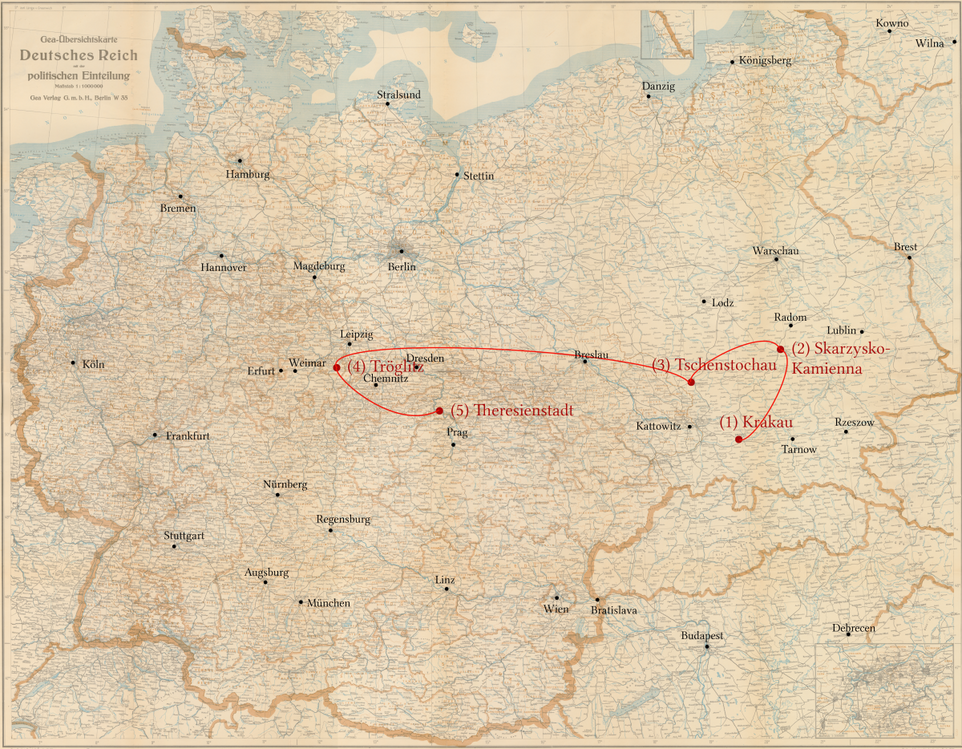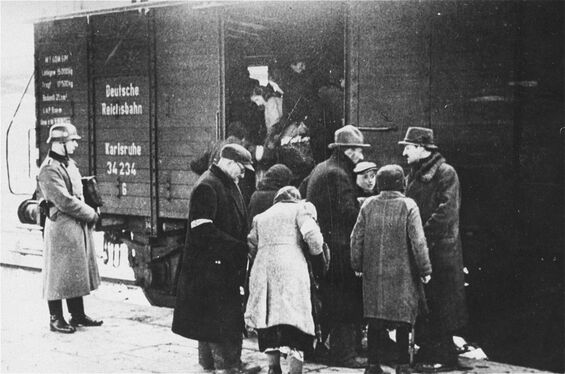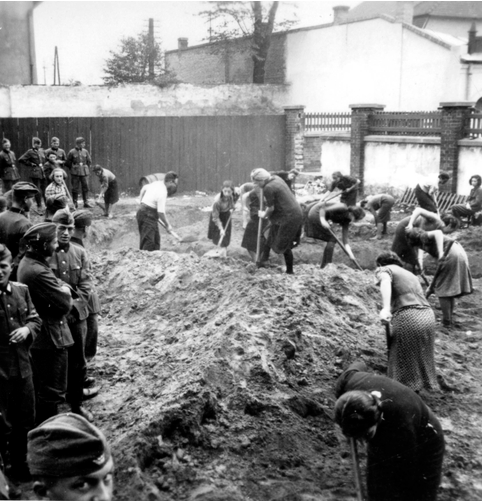The Biography of Abraham Rimler, Krakow
Short biography and stations of his persecution
- born on 5 September 1914 in Krakow
- worked as a merchant
- had to perform forced labour as a construction worker in the Krakow ghetto from June 1941 to May 1942
- was in the Krakow-Plaszow forced labour camp from May 1942 to the end of 1943, working as a welder
- then worked for about 7 months in the Skarzysko-Kamienna forced labour camp in the munitions factory
- was in the forced labour camp Tschenstochau/HASAG Rakow from mid-1944
- was sent to Buchenwald concentration camp/Tröglitz subcamp at the beginning of 1945
- was in the Theresienstadt ghetto from 4/1945 - 9 May 1945 (liberation)
- later in Krakow, in the Displaced Persons Camps Eschwege, Hessisch-Lichtenau, Kassel, Landsberg/Lech
Abraham Rimler lost his family, his parents and his five siblings.
Before the War
Until the outbreak of the war, I was a strong, healthy young man and had no physical ailments. I worked as a businessman and earned enough. During the time of persecution, I had to suffer unspeakable hardships.
Source: Unless otherwise stated: Konrad Kittl files, Abraham Rimler affidavit
Krakow ghetto, Plaszow, Skarzysko, Tschenstochau
In the Krakow ghetto, I had to do the hardest work - construction work - in the so-called building and civil engineering company. I was often mistreated at work. But the worst thing for me was that my family, my parents and five of my siblings, were dragged away and I never saw them again. I also expected to die at any moment. I was physically completely broken by Krakow. I was emaciated and so weak that I could only go to work with the greatest effort of will. I was put to work in the so-called steel mill. I had to do the work of a press welder. One day, when I was no longer able to work properly, a guard, nicknamed 'Rothkopf', came and, because he wasn't happy with my work, beat me on the back with an iron stick until I collapsed unconscious. Nobody could help me. Fearing death, I picked myself up again and carried on working. I have been suffering from back pain ever since.
| Forced labour camps for Jews in the "Generalgouvernement" | |
|---|---|
| Place | Skarżysko-Kamienna |
| Name | |
| Area | General Government, Radom District (1939-1945) |
| Opening | Men: January 1940 (first mention); Women: April 1940 (first mention) |
| Closing | October 1944 (last mention): The male prisoners were "evacuated" in June/August 1944 to the forced labour camp for Jews in Czestochowa and to Buchenwald concentration camp. The female prisoners were "evacuated" to the Leipzig subcamp of Buchenwald concentration camp in August 1944 / The camp was "evacuated" in July 1944: 4,000 Jews were deported to the Hasag headquarters in Leipzig and around 3,000 to the Hasag factories in Czestochowa</td |
| Deportations | In 1942, several transports of prisoners arrived at the camp, including around 2,000 Jews from Kielce and around 500 from Checiny, in March and November from Plaszów and then around 1,900 from Majdanek, and in early March 1944 around 1,600 from the Lodz ghetto. A transport of around 2,000 prisoners from Plaszów also reached the camp in March.</td |
| Prisons | At times there were 8,000 prisoners in the camp. |
| Gender | Men, women and children |
| Employment of the prisoners at | HASAG (Hugo Schneider AG); United Electricity Works of the Radom and Kielce Districts |
| Type of work | Men: work in the munitions factory, railway construction; women: Labour in the munitions factory |
| Remarks | In March 1944, all the children in the camp were murdered |
| Source: deutschland-ein-denkmal.de | |
| Forced labour camps for Jews in the "Generalgouvernement" | |
|---|---|
| Location | Częstochowa / Częstochowa |
| Name | HASAG Rakow |
| Area | General Government, Radom District (1939-1945) |
| Opening | June 1943 |
| Closing | 15 January 1945; the prisoners were "evacuated" to Buchenwald concentration camp; liberation on 16 January 1945 |
| Deportations | |
| Prisons | |
| Gender | Men |
| Employment of the prisoners at | HASAG (Hugo Schneider AG) Rakow ironworks |
| Type of work | |
| Source: deutschland-ein-denkmal.de | |
Buchenwald/Tröglitz
From the Czenstochau camp, I was dragged to the Buchenwald concentration camp. I was given the prisoner number 116852 and the conditions here were even worse. In the Seit-Treglitz camp (1) I had to work in the production of synthetic petrol. We were constantly harassed and beaten at work. Many of my fellow prisoners died.
Note (1) Tröglitz, Zeitz plant of BRABAG
| Subcamps of the Buchenwald concentration camp | |
|---|---|
| Location | Tröglitz, municipality of Rehmsdorf |
| Name | "Will" |
| Territory | Prussia (Province of Saxony) |
| Opening | 05 June 1944 |
| Closing | "Evacuation" on 09/04/1945 to Wittenberge |
| Deportations | |
| Prisons | Up to 4,250, mainly Jews |
| Gender | Men |
| Employment of the prisoners at | BRABAG (Braunkohle-Benzin AG); Zeitz plant |
| Type of work | Clean-up work (e.g. defusing unexploded bombs), work in road, civil engineering and railway construction, construction of anti-aircraft positions to ensure the production of synthetic fuel |
| Comments | 200 Dutch prisoners (housed in the oxen shed of the sugar factory and in the Harnisch estate in Gleina) built a tent camp for the later prisoners on Rehmsdorfer Straße in June 1944. At the end of 1944, a new camp was set up in Rehmsdorf under the direction of the Organisation Todt.</td |
| Source: deutschland-ein-denkmal.de | |
"Evacuation" from Buchenwald
We were then dragged from Buchenwald to other concentration camps as the Russians approached the area, i.e. we were put on the so-called death march. At first we were transported by wagons.
At Reitzenheim station, the railway station was bombed and our train was hit. All the prisoners and the SS who were guarding us ran away. We ran into the surrounding woods, but soon things got organised and the SS came from all sides. Anyone who ran away and tried to hide was shot mercilessly. I also got a graze shot back then, the little toe of my right foot was injured. Fearing that I was about to be shot, I went back to the train with my shot foot and told the SS that I wanted to return to my commando.
I was lucky that they couldn't see my injury. I dragged myself onwards in great pain and arrived at the Theresienstadt concentration camp.
Theresienstadt
When I arrived here, I soon had severe typhoid fever. The last few days before liberation I ran around like a dead man and couldn't move at all. My foot was terribly swollen.
Krakau, West Germany
I travelled from Theresienstadt to Krakow. I didn't stay in Krakow for very long, pogroms were starting at the time and I more or less had to hide. From Krakow I travelled to West Germany and was first sent to the DP camp in Eschwege, later I was in the DP camp in Hessisch-Lichtenau, then in Kassel and when the camp was dissolved I was sent to Landsberg-Lech.
During the whole time I was under medical treatment. I can't remember the doctors who looked after me in Krakow, I don't even know my address at that time in Krakow. I was very often in hospitals in the DP camps in West Germany. I can't remember the individual hospitals or the doctors - so please ask the International Red Cross.
Anmerkungen
Weitere Quellen
-----
Entschädigungsamt
Darmstadt 1958- , AZ D/14954/14
Anmerkungen
Erläuterungen zu dem Dokumenten aus den Arolsen Archives siehe den e-guide, z.B für Arbeitseinsatzkarten, oder C/M 1 Anträgen
Bildnachweis
- A member of the German SS supervises the boarding of Jews onto trains during a deportation action in the Krakow ghetto. United States Holocaust Memorial Museum, Photograph Number: 02159
- Krakow, Poland, German policemen watching the Jewish forced labor workers. Yad Vashem, Archival Signature 4572/6
- C/M 1 Akten aus Deutschland, Abraham Rimler, 3.2.1.1/79677744 ITS Digital Archive, Arolsen Archives
- C/M 1 Akten aus Deutschland, Abraham Rimler, 3.2.1.1/79677744 ITS Digital Archive, Arolsen Archives



![C/M 1 Bogen Abraham Rimler, Quelle: [3] C/M 1 Bogen Abraham Rimler, Quelle: [3]](/files/Bilder/AbrahamRimler/cm1_2_3.2.1.1_79677744.jpg)
![C/M 1 Bogen Abraham Rimler, Seite 2, Quelle: [4] C/M 1 Bogen Abraham Rimler, Seite 2, Quelle: [4]](/files/Bilder/AbrahamRimler/cm1_3-1_3.2.1.1_79677744.jpg)
![C/M 1 Bogen Abraham Rimler, Seite 3, Quelle: [5] C/M 1 Bogen Abraham Rimler, Seite 3, Quelle: [5]](/files/Bilder/AbrahamRimler/cm1_3-2_3.2.1.1_79677744.jpg)